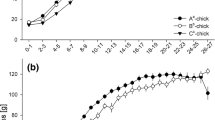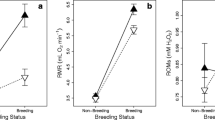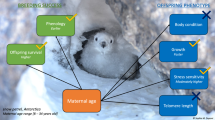Abstract
In the terrestrial salamander (Plethodon cinereus), previous work has shown that mother’s body size is positively correlated to offspring size at the time of hatching even after controlling for the effects of egg size. This study was designed to determine whether maternal body size affects offspring size via pre-oviposition factors (e.g., yolk quality, jelly coat composition, or maternal genes) or post-oviposition factors (e.g., parental care behaviors, parental modification of environment). Gravid females were captured and induced to lay eggs in experimental chambers in which the environment was standardized. Fifteen clutches were exchanged, or cross-fostered, between female pairs differing in body size. Ten females whose eggs were taken away and then returned served as controls for the crossing treatment. Foster mothers did not significantly differ from control mothers in the time spent with eggs, body position, or number of egg movements during brooding. Average egg mass measured midway through development was not significantly correlated to the body size of either the genetic or foster mother, but was correlated to pre-oviposition oocyte size. At hatching, offspring body length was positively correlated to egg size and the foster mother’s body size. This correlation suggests that in P. cinereus post-oviposition maternal effects have a greater impact on offspring size than other maternal factors incorporated into the egg prior to oviposition. While our study showed that larger mothers moved their eggs less often and tended to spend more time in contact with their eggs, further work needs to be done to identify the specific mechanisms through which larger mothers influence the body size of their offspring. This is the first experimental demonstration of post-oviposition maternal effects for any amphibian with parental care.


Similar content being viewed by others
References
Atchley WR, Rutledge JJ (1980) Genetic components of size and shape. I. Dynamics of components of phenotypic variability and variability during ontogeny in the laboratory rat. Evolution 34:1161–1173
Austin RM Jr (2000) Cutaneous microbial flora and antibiosis in Plethodon ventralis: Inferences for parental care in the Plethodontidae. In: Bruce RC, Jaeger RB, Houck LD (eds) The biology of the plethodontid salamanders. Kluwer Academic/Plenum, New York
Bernardo J (1996) Maternal effects in animal zoology. Am Zool 36:83–105
Conant R, Collins JT (1991) Reptiles and amphibians of eastern/central North America, 3rd edn. Houghton Mifflin, Boston
Crespi EJ (2001) Adaptation of reproductive strategies: Endocrine and ecological factors associated with the evolution of terrestrial breeding in amphibians. PhD Dissertation. University of Virginia, Charlottesville, Va.
Dhondt AA (1982) Heritability of blue tit tarsus length from normal and cross-fostered broods. Evolution 36:418–419
Donohue K (1999) Seed dispersal as a maternally influenced character: Mechanistic basis of maternal effects and selection on maternal characters in an annual plant. Am Nat 154:674–689
Forester DC (1981) Parental care in the salamander Desmognathus ochrophaeus: Female activity pattern and trophic behavior. J Herpetol 15:29–34
Forester DC (1983) Duration of the brooding period in the mountain dusky salamander (Desmognathus ochrophaeus) and its influence on aggression toward conspecifics. Copeia 1983:1098–1101
Forester DC (1984) Brooding behavior by the mountain dusky salamander: Can the female’s presence reduce clutch desiccation? Herpetologica 40:105–109
Gabor CR (1995) Correlational test of Mathis’ hypothesis that bigger salamanders have better territories. Copeia 3:729–735
Galloway LF (2001) The effect of maternal and paternal environments on seed characters in the herbaceous plant Campanula americana (Campanulaceae). Am J Bot 88:832–840
Highton R, Savage T (1961) Functions of the brooding behavior in the female red-backed salamander, Plethodon cinereus. Copeia 1961:95–98
Jaeger RG (1972) Food as a limited resource in competition between two species of terrestrial salamanders. J. Herpetol 8:191–194
Jaeger RG (1979) Seasonal spatial distributions of the terrestrial salamander Plethodon cinereus. Herpetologica 35:90–93
Kaplan RH (1998) Maternal effects, developmental plasticity, and life history evolution. An amphibian model. In: Mousseau TA, Fox C (eds) Maternal effects as adaptations. Oxford University Press, Oxford, pp 244–260
Kay B, Peng B (1991) Methods in cell biology, vol. 36, Xenopus laevis: Practical uses in cell and molecular biology. Academic Press, New York
Kirkpatrick M, Lande R (1989) The evolution of maternal characters. Evolution 43:485–503
Lacey EP (1998) What is an adaptive environmentally-induced parental effect? In: Mousseau TA, Fox C (eds) Maternal effects as adaptations. Oxford University Press, Oxford, pp 54–66
Mathis A (1990) Territoriality in a terrestrial salamander: The influence of resource quality and body size. Behavior 112:162–175
Mousseau TA, Dingle H (1991) Maternal effects in insect life histories. Annu Rev Entomol 36:511–534
Mousseau TA, Fox CW (1998) The adaptive significance of maternal effects. Trends Ecol Evol 13:403–407
Ng M, Wilbur HM (1995) The cost of brooding in Plethodon cinereus. Herpetologica 51:1–8
Resetarits WJ Jr (1996) Oviposition site choice and life history evolution. Am Zool 36:205–215
Resetarits WJ Jr, Wilbur HM (1989) Choice of oviposition site in Hyla chrysoscelis: Role of predators and competitors. Ecology 70:220–228
Ricklefs RE, Smeraski CA (1983) Variation in incubation period within a population of the European starling. Auk 100:926–931
Roach DA, Wulff RD (1987) Maternal effects in plants. Annu Rev Ecol Syst 18:209–235
Roff DA (1998) The detection and measurement of maternal effects. In: Mousseau TA, Fox CW (eds) Maternal effects as adaptations. Oxford University Press, New York, pp 83–96
Rutledge JJ, Robison OW, Eisen EJ, Legates JE (1972) Dynamics of genetic and maternal effects in mice. J Anim Sci 35:911–918
Salthe SN, Mecham JS (1974) Reproductive and courtship patterns. In: Lofts B (ed) Physiology of the amphibia, vol 2. Academic Press, New York, pp 310–522
SAS Institute, Inc. (2000) SAS v.8.1 for Windows. Cary, N.C.
Sayler A (1966) The reproductive ecology of the red-backed salamander, Plethodon cinereus, in Maryland. Copeia 1966:183–193
Sinervo B, Doughty P (1996) Interactive effects of offspring size and timing of reproduction on offspring reproduction: Experimental, maternal, and quantitative genetics aspects. Evolution 50:1314–1327
Smith HG, Wettermark, KJ (1995) Heritability of nestling growth in cross-fostered European starlings Sturnus vulgaris. Genetics 141:657–665
Taigen TL, Pough FH, Stewart MM (1984) Water balance of terrestrial anuran (Eleutherodactylus coqui) eggs: Importance of parental care. Ecology 65:248–255
Tilley SG (1972) Aspects of parental care and embryonic development in Desmognathus ochrophaeus. Copeia 1972:532–540
Acknowledgements
We thank H. Wilbur for his advice and guidance throughout this project. We also thank the students and faculty at Mountain Lake Biological Station during the summer of 2000 for their assistance in the execution of the experiment, especially E. Nagy, J. Watters, I. Parker-Renga, and J. McGlothlin. This study was funded by Mountain Lake Biological Station; a National Science Foundation Research Experience for Undergraduates (REU) program awarded to Mountain Lake Biological Station (DBI-973215); and a National Science Foundation Doctoral Dissertation Improvement Grant awarded to Henry Wilbur and Erica Crespi (IBN-9972674).
Author information
Authors and Affiliations
Corresponding author
Rights and permissions
About this article
Cite this article
Crespi, E.J., Lessig, H. Mothers influence offspring body size through post-oviposition maternal effects in the redbacked salamander, Plethodon cinereus . Oecologia 138, 306–311 (2004). https://doi.org/10.1007/s00442-003-1410-5
Received:
Accepted:
Published:
Issue Date:
DOI: https://doi.org/10.1007/s00442-003-1410-5




